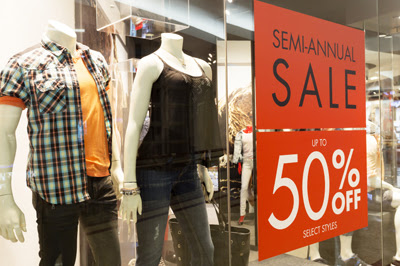While most of us limit our practical jokes to the first day of April, retailers use several tricks to fool shoppers all year long into spending their hard-earned dollars. As consumer behavior shifts more toward experiences over products, stores are getting sneakier with their sales strategies, duping customers in increasingly deceptive ways.
Consider the following retail traps that make you look a fool, and how to avoid them during your next shopping trip.

1. Dressing room deceptions.
Some retailers use special lighting, tilted mirrors and even special products to make customers appear slimmer and tanner in dressing rooms. This strategy was the subject of a recent TODAY Show Rossen Reports segment that profiled the creator of a mirror that made shoppers look 10 to 15 pounds lighter. When you feel more attractive in an article of clothing, you’re more likely to buy it, so retailers go to great lengths to create a flattering reflection which encourages you to spend. Evaluate a purchase based on how closely it meets your needs and budget, and make sure the store accepts returns for a full refund if you decide later that you aren’t happy with the fit and style.
2. Charm pricing.
Price tags that end with 0.09, 0.95 and 0.99 are statistically more attractive to consumers compared to full-dollar pricing. Why? Because shoppers tend to only focus on the number to the left of the decimal point, a tendency dubbed the “left-digit effect.” For example, consumers are more likely to purchase an item priced at $4.99 compared to one price at $5.00, even though the difference is just one cent. The perceived difference is much greater since consumers typically round down, and retailers use this to their advantage. Get in the habit of rounding up before making your buying decision!
3. Urgent promotions and emails.
Creating a sense of urgency is the bedrock of many promotions and messages and represents a great way to get consumers to make impulse purchases. When shoppers receive an email with “limited-time only” deals or “one-day” sales, they’re more likely to buy immediately for fear of missing out on the savings opportunity. Sales and promotions are recurring, though, so consumers almost always have the opportunity to take advantage of discounts at any given time. Unsubscribe from retailers’ e-newsletters and use sites likeCouponSherpa.com for printable and online coupons when you need them.
4. Purchase minimums.
Shoppers like to think they’re in control of their spending, but retailers are sneaky in getting consumers to buy more than they intended. Free shipping minimums are examples of threshold offers used by online retailers to force customers to spend a certain amount to qualify for free delivery. Bounce-back offers like Kohl’s Cash are another popular strategy which requires customers to fulfill a minimum spend in order to receive a savings voucher for a future visit. Don’t let retailers dictate your purchase amount and wait for a free shipping offer or search for codes on FreeShipping.org, and earn bounce-back offers only when your planned spend meets the criteria.
5. Store-card discounts.
Playing off a shopper’s desire to save money, retailers promote new discounts with a one-time deal of 10 to 20% off to those who apply for a store credit card. While these initial savings are tempting, the long-term benefits of these strategies are suspect. Retail associates are often incentivized to pitch store credit cards that feature low credit limits and high APRs, neither of which are ideal for customer budgets or credit scores. What’s more, store’s know that consumers are likely to buy more in that first initial visit to maximize the discount savings and will be prone to increase spending when swiping a card. It’s best to stick with one major credit card that offers cash-back rewards or travel points.
6. Tiered savings.
The slogan “buy more, save more” is used by many retailers, from clothing to furniture stores, to create the perception of extra value. These tiered savings include deals like $10 off $50, $15 off $75 or $20 off $100. While it’s tempting to opt for the biggest savings ($20 in this example), each deal represents the same savings of 20%. Tiered discounts drive shoppers to spend more to yield a greater savings even though the deal is the same in each example. In reality, the more money you spend, the less you have in your wallet or bank account, so don’t let these types of offers fool you into buying more!
Feel free to share “6 Retail Tricks That Make You Look Foolish” with your audience, giving proper attribution to the source.
###

Andrea Woroch is a money-saving expert who transforms everyday consumers into savvy shoppers by sharing smart spending tips and personal finance advice. As a sought-after media source, she has been featured among such top news outlets as Good Morning America, Today, CNN, Dr. OZ, New York Times, MONEY Magazine, Consumer Reports, Forbes and many more. In addition, Andrea’s stories have been published among leading publications and sites such as Yahoo!, AOL Daily Finance, CNN Money, Huffington Post, LearnVest and New York Daily News. Check out Andrea’s demo reel or visit her website at AndreaWoroch.com for more information about booking an interview or requesting an original written article. You can also follow her on Twitter orFacebook for daily money tips.

